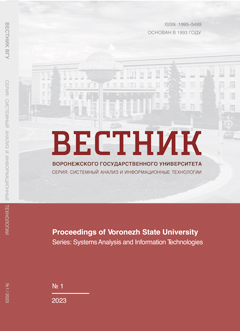Выявление выбросов в данных практически однородных технических систем
Аннотация
В статье представлен метод выявления выбросов в данных о том или ином параметре практически однородных технических систем(далее ПОТС) имеющих форму временных рядов путем их сравнительного анализа, отражающего случаи невозможности его проведения. Метод весьма актуален в силу распространенности применения временных рядов в различных современных технических системах. Для разработки метода был проведен неисчерпывающий обзор различных методов обнаружения дефектов в данных. Основное внимание в обзоре было приковано к обнаружению выбросов, так как такой дефект как пропуски в данных присутствуют в них практически в явном виде. Рассмотрены некоторые достоинства и недостатки методов обнаружения выбросов, с учетом которых была произведена разработка метода. Метод обладает широкими перспективами его дальнейшего применения, так как может помочь в выявлении выбросов в данных исследуемых систем, а также в случае сходства данных может дать дополнительную уверенность исследователю о том, что системы, данные которых исследуются находились в обозначенное время в исправном состоянии в практически равных условиях. В свою очередь, различие может говорить о наличии в данных выбросов, причинами наличия которых могут быть: неисправности той или иной из систем или в системе сбора и хранения данных о них, влиянием на ту или иную систем неучтенного фактора. Несмотря на некоторую субъективность, метод имеет существенный плюс в виде гибкости, кроме того, он не требует построения сложных моделей определяющих эталонное поведение исследуемого параметра ПОТС для проведения сравнительного анализа данных модели и исследуемых систем, что указывает на перспективность его применения для анализа данных даже сложных ПОТС.
Скачивания
Литература
2. Desherevskii A. V. [et al.] (2017) Problems in analyzing time series with gaps and their solution with the WinABD software package. Izvestiya, Atmospheric and Oceanic Physics. 53(7). P. 659–678. DOI
3. Kontsevaya N. V. (2012) The analysis of methods of filling of admissions in temporary ranks of indicators of the financial markets. Vestnik Voronezhskogo gosudarstvennogo universiteta. (8). P. 18–20. (in Russian)
4. Zymbler M. L. [et al.] (2021) Cleaning sensor data in Intelligent Heating Control System. Bulletin of the South Ural State University. Series “Computational Mathematics and Software Engineering”. 10(3). P. 16–36. DOI
5. Turner W. J. N., Staino A. and Basu B. (2017) Residential HVAC fault detection using a system identification approach. Energy and Buildings. 151. P. 1–17. DOI
6. Farouq S. [et al.] (2020) Large-scale monitoring of operationally diverse district heat ing substations: A reference-group based approach. Engineering Applications of Artificial Intelligence. 90. P. 103–492. DOI
7. Generalov I. G., Zavivaeva O. E. and Suslov S. A. (2019) Anomalies in the structure of time series when assessing the stability of grain production. Azimuth of scientific research: economics and administration. 8(29). P. 351–354. DOI
8. Zimek A. and Filzmoser P. (2018) There and back again: Outlier detection be-tween statistical reasoning and data mining algorithms. WIREs Data Mining and Knowledge Discovery. 8(6). P. 1280. DOI
9. Huang X. [et al.] (2016) Time Series K-means: A new K-means type smooth subspace clustering for time series data. Information Sciences. 367(368). P. 1–13. DOI
10. Pestunov I. A. and Sinyavskiy Yu. N. (2012) Clustering algorithms in satellite images segmentation tasks. Vestnik Kemerovskogo gosudarstvennogo universiteta. Series “Mathematics”. 4(52). P. 1–13. (in Russian)
11. Zueva V. N. (2017) Regressive methods of prognostication of the load-graph of electrical equipment. Polythematic Online Scientific Journal of Kuban State Agrarian University. 126(2). P. 1–12. DOI
12. Torgashin A. S. [et al.] (2022) Method for processing the results of cavitation tests of TNA pumps in order to obtain an approximating function. Siberian Aerospace Journal. 23(3). P. 498–507. DOI
13. Ikuta S. [et al.] (2023) Development of bicarbonate buffer flow-through cell dissolution test and its application in prediction of in vivo performance of colon targeting tablets. European Journal of Pharmaceutical Sciences. (180), 106326. DOI
14. Boyarsky M. V. (2003) On the detection and elimination of anomalous results of observations in woodworking processes. Izvestiya VUZov. Forest magazine. 1. P. 66–70. (in Russian)
15. Popukailo V. S. (2016) Construction of a mathematical model for the efficiency of a bank in a small sample. Actual problems of the humanities and natural sciences. 3(2). P. 1–6. (in Russian)
16. Vodanyuk S. A. (2013) The practice of applying a comparative approach to the assessment of claims (receivables). Property relations in the Russian Federation. 6(141). P. 42–53. (in Russian)
17. Petrovskaya Y. A. (2015) Methods for Eliminating Gross Error. Actual problems of aviation and cosmonautics. (11). P. 109–110. (in Russian)
18. Saha S. [et al.] (2020) A statistical and numerical modeling approach for spatiotemporal reconstruction of glaciations in the Central Asian Mountains. MethodsX. (7). 100820 DOI
19. Muravyov P. A. and Dementiev M. V. (2011) Cleaning time series from outliers. Health and education in the XXI century. 3. P. 328–329. (in Russian)
20. Pozolotin V. E. and Sultanova E. A. (2019) Application of data transformation algorithms in the analysis of time series to eliminate outliers. Software systems and computational methods. 2(2). P. 33–42. DOI
- Авторы сохраняют за собой авторские права и предоставляют журналу право первой публикации работы, которая по истечении 6 месяцев после публикации автоматически лицензируется на условиях Creative Commons Attribution License , которая позволяет другим распространять данную работу с обязательным сохранением ссылок на авторов оригинальной работы и оригинальную публикацию в этом журнале.
- Авторы имеют право размещать их работу в сети Интернет (например в институтском хранилище или персональном сайте) до и во время процесса рассмотрения ее данным журналом, так как это может привести к продуктивному обсуждению и большему количеству ссылок на данную работу (См. The Effect of Open Access).



















